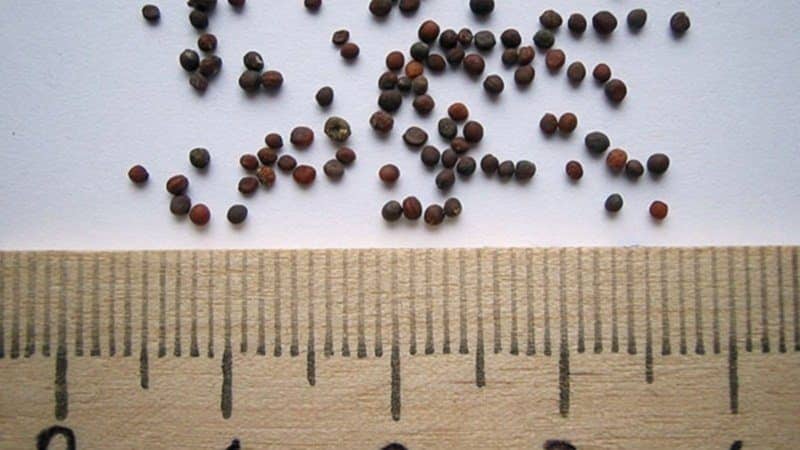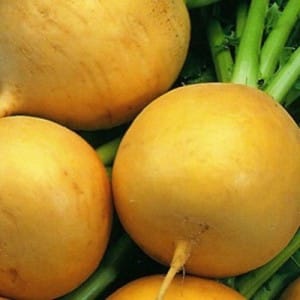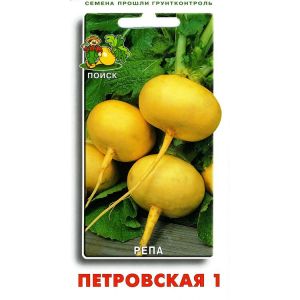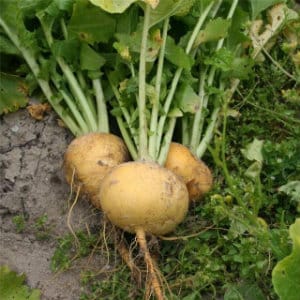Turnip seeds - how to choose the best variety
Turnips are quite rightly called an original Russian vegetable. The root vegetable was once so popular that it became the hero of several well-known and beloved fairy tales. Today, for some reason, this amazing vegetable is undeservedly forgotten. And in vain, because it is much superior to potatoes, which are firmly established in our menu, in terms of the number of microelements; it contains glucoraphanin, which reduces the risk of developing diabetes and other diseases.
There are many varieties and varieties of turnips. To grow a rich harvest, it is important to take a responsible approach to the choice of planting material. We'll tell you about the best varieties of turnips with photos and descriptions.
What turnip seeds look like

Externally, turnip seeds are unremarkable - they are small black or dark brown balls with a diameter of 2-3 mm. The color and size of the seed largely depend on the variety. Since the seeds are very small, they are often mixed with sand or soil before planting.
Many of the seeds are hollow or deformed. Some can be determined by eye, but it is better to use a proven method: make a 5% solution of table salt and pour the seeds into it. Good seeds will sink to the bottom, unsuitable seeds will float to the surface.
Reference. Turnip It is considered one of the oldest plants cultivated by man. Historians say that it is at least 5-6 thousand years old. Western Asia is considered the homeland of the vegetable. In Ancient Egypt, turnips were the food of the poorest segments of the population, but in Ancient Rome, on the contrary, they decorated the tables of the patricians.In Rus', turnips were mentioned more than once in ancient chronicles and in the literature of the Silver Age, being almost the main dish on the tables of both commoners and the upper class.
Types and best varieties of turnips
The yield of turnips largely depends on the variety and region in which it is grown. With the correct selection of seed, proper planting and care, this nutritious vegetable will delight you with two harvests a year.
The varieties are table and fodder. Among the canteens, a salad group is distinguished. If table turnips use only root vegetables for food, then salad turnips are valuable not only for their roots, but also for their leaves.
Varieties also differ in ripening time. There are early (1.5-2 months), middle (2-3 months) and late, which require at least 3 months to ripen. The plant is biennial.
Most varieties of this vegetable produce a full harvest only in the second year after sowing. But today many varieties have been bred that can be called hyper-early ripening. They produce 2 harvests per year. By the way, turnips are sown in early spring.
There are many varieties and varieties of turnips on the market today. Most of the seeds are of domestic origin, some are bred abroad.
Table turnips
For a long time in Rus', children were forced to eat turnips - the plant saved younger generations from rickets and other diseases associated with a deficiency of vitamins in the diet. The root vegetable contains succinic acid, as well as vitamins C, B1 and B2, it contains a huge amount of carotene (the yellower the fruit, the more there is).
One of the special features of turnips is its low calorie content. In recent years, it has become an integral part of weight loss diets. But the juice from the root, mixed with honey, perfectly treats coughs in both children and adults.
Petrovskaya
This is the most famous of the domestic turnip varieties. Moreover, one of the oldest. Petrovskaya belongs to the table mid-season varieties. After the emergence of seedlings, at least 2 months pass before the root crop ripens. A ripe vegetable weighs from 60 to 130 g, but there are specimens weighing 0.5 kg.
From 1 m², 1.5-3 kg of turnips of this variety are harvested. It is consumed fresh, pickled and made into stews.
Young shoots are not afraid of frost. It’s good if Petrovskaya’s predecessors when planting were potatoes, cucumbers or tomatoes.
If the crop is not harvested before frost, then frozen vegetables cannot be stored.
Petrovskaya-1
 Petrovskaya-1 belongs to the mid-early table varieties. The culture is unpretentious and stores well even with slight freezing. The fruits are yellow, round and slightly flattened.
Petrovskaya-1 belongs to the mid-early table varieties. The culture is unpretentious and stores well even with slight freezing. The fruits are yellow, round and slightly flattened.
The fruit is juicy, weighs up to 0.5 kg, but more often – 150-200 g, and has a sweetish taste. When planting, it is better to place a larger distance between future plants, since the fruits of the Petrovskaya-1 turnip are quite large.
Milanese pink
It belongs to early ripening, high-yielding and disease-resistant varieties. Ripening occurs in 50-55 days. The root crop is rounded-flat, pink-purple, and has a light tip. Ripe turnips weigh from 100 to 200 g.
Vegetables of this variety must be watered more thoroughly than most other analogues, since Milanese rose is more demanding of soil moisture and prefers sandy loam and loam.
Grandma
Babka is a mid-early, high-yielding variety. Technical maturity occurs in at least 2 months. The ripe vegetable has round, golden-yellow, smooth and shiny fruits. A mature root vegetable weighs up to 200 g and has excellent taste.
The harvest is suitable for long-term storage. Grandma gravitates towards loamy soils. The best predecessors on the site are cucumbers, tomatoes, and legumes. Root crops are harvested selectively, depending on the maturity achieved.
Bug
The turnip, named after another character in a popular fairy tale, belongs to the early-ripening varietal material. No more than 1.5 months pass from the moment the seedlings emerge to full ripening. The root vegetables are golden yellow in color, fleshy, weighing up to 0.5 kg. It is considered one of the highest yielding varieties. From 1 m² they collect up to 5 kg. The vegetable is perfectly stored if it is not frozen before harvesting.
Golden ball
The peculiarity of the Golden Ball is its unpretentiousness. It is resistant to cold weather and also produces consistently high yields, especially on loamy soils. The root vegetables are round, yellow, weigh up to 200 g, their skin is smooth and tender, and the pulp is juicy and dense. Ripening occurs in 2 months.
Golden ball maintains high yield in areas with late spring and cool climates. Where the vast majority of other turnip varieties suffer from climatic factors, it is the Golden Ball that shows consistently high results.
This is interesting:
What types of carrot seeds are there, how to choose and plant them correctly.
Rules for storing seed potatoes: instructions for preparing seeds.
A selection of the best recipes for sauerkraut with dill and its seeds.
Lettuce leaf turnip
Turnips of salad varieties are distinguished by a high content of ascorbic acid; they are rich in beta-carotene, vitamins B and E, and mineral salts. The leaves contain huge amounts of calcium. With regular consumption of salad turnips, bone tissue is strengthened, and the risk of osteoporosis is significantly reduced.
Geisha
The variety with such an intriguing name belongs to the early-ripening table variety - it is a subspecies of the kokaboo turnip, common in Japan. The fruits are white, round and weigh up to 200 g. Geisha belongs to the table and salad category, so not only root vegetables, but also tender leaves rich in vitamins are suitable for food.
Planting is carried out in early spring; maturation will take no more than 1.5 months. According to reviews from gardeners, Geisha is a cold-resistant, shade-tolerant and bloom-resistant variety.
Komatsuna
This is what the familiar spinach is sometimes called. The plant belongs to the salad varieties; the root vegetables weigh little - only about 20-30 g.
Komatsuna is cold-resistant and adapts well to home growing conditions. From the moment the shoots appear until the harvest takes place, only one month passes. The leaves do not taste bitter, they are tender and rich in vitamins.
The plant loves moisture and is resistant to stemming. The crop is harvested at least three times a year. Sowing is carried out in the early spring months and in mid-August. Excellent for growing in greenhouses.
Granddaughter
Turnips of the Vnuchka variety are considered both table and salad turnips at the same time. The hybrid variety has juicy root vegetables that weigh up to 150 g, as well as delicate and slightly sour-tasting purple leaves. From the moment of sowing to harvesting, up to 1.5 months pass.
The variety is considered early ripening. Its versatility has earned it great popularity, especially among summer residents in central Russia. Granddaughter cannot be called a frost-resistant variety, so it is advisable to harvest it long before the first frost.
Reference. Today, the number of popular turnip varieties reaches 30. In fact, there are many more.Breeders are constantly introducing more and more new types of seed, adapted to the specific conditions of certain regions: soil, humidity, weather conditions, etc.
For central Russia

The temperate region is ideal for growing almost all varieties of turnips. This vegetable grows well in central Russia; consistently high yields are harvested here.
The main thing is to choose the right soil in accordance with the variety being planted.
It is also necessary to decide where exactly the vegetable will be grown - in open ground or in a greenhouse. When planning a harvest, it is better to make preliminary calculations; this will save you from wasting effort and money.
For Siberia
In the harsh conditions of Siberia, it is better to use frost-resistant turnip varieties. If we are talking about the northern part of the region, where the summer is short, then it is better to grow early ripening ones, because the ripening period in this case should not be more than 1.5-2 months.
The best for Siberia are:
- May yellow;
- Moon;
- Early purple;
- Tokyo.
Varieties for open ground
The unpretentiousness of this healthy and vitamin-rich vegetable makes it possible to grow it both in open ground and in greenhouses, and even indoors.
The best varieties of turnip seeds for open ground are:
- Geisha;

- Petrovskaya-1;
- Lyra;
- Dedka;
- Snow White;
- Nurse;
- Snowball;
- Russian size;
- Orbit;
- Sapphire.
For the greenhouse
Turnips grown in a greenhouse are almost no different from those grown in open ground. However, experts recommend the following varieties for greenhouse cultivation:
- Comet;
- White Night;
- Snow Maiden;
- A chidhood dream;
- Russian fairy tale;
- Bug;
- Komatsuna.
Which varieties are resistant to bolting?
Shooting, if not dealt with in time, will lead to complete or partial loss of the crop. As a rule, the following varieties of turnips are not included:
- Russian fairy tale;
- Comet;
- Orbit;
- Tokyo;
- Petrovskaya-1.
Sweet varieties
Turnips come in many flavors. There is bitter, sweet and even sour. The most favorite are the sweet varieties, including:
- Golden ball;
- Dunyasha;
- Milanese pink.
Most productive
Any agrarian, be it a large agricultural producer, an average farmer or just an ordinary summer resident, always strives for high yields. Suitable varieties:
- Petrovskaya-1;
- Tokyo;
- Snow White.
Early varieties
We list the early ripening varieties of turnips:
- Geisha;
- Milanese pink;
- Dedka;
- Glasha;
- May yellow;
- Granddaughter.
Mid-season varieties
Mid-season varieties include:
- Dunyasha;
- Moon;
- Nurse;
- Gribovskaya.
Late varieties
Late ripening varieties include:
- Comet;
- Orbit;
- Gribovskaya local.
Conclusion
Today, turnips are experiencing something of a renaissance. The renewed interest in it is causing the emergence of more and more new varieties. This unpretentious vegetable is once again becoming a regular on tables and is increasingly used in folk medicine. It’s not for nothing that turnips are popularly called Russian ginseng or the royal root.